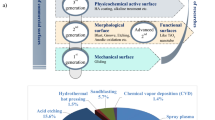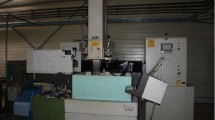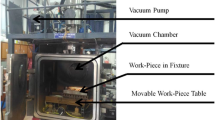Abstract
Implant treatment is one of the most important surgical processes in teeth which reduces the difficulties in teeth by providing the interface between bone and jaw. The established implant treatment used to support the denture, bridge and teeth crown. Even though it supports many dental related activities, the successive measure of implant treatment is fail to manage because it fully depends on the patient’s personal activities and health condition of mouth tissues. So, the successive rate of implant treatment process is identified by applying the memetic search optimization along with Genetic scale recurrent neural network method. The introduced method analyzes the patient characteristics which helps to recognize the successive and failure rate of implant treatment process. The quality of the implant treatment of using simulation results in terms of sensitivity, specificity and accuracy metrics.





Similar content being viewed by others
References
Orzabadi-Farahani, A., Zadeh, H. H., Orthodontic therapy in implant dentistry: Orthodontic implant site development. In Tolstunov, L. Vertical alveolar ridge augmentation in implant dentistry: A surgical manual. Hoboken: John Wiley & Sons. pp. 30–37. https://doi.org/10.1002/9781119082835.ch04, 2016.
Sinn, D. P., Bedrossian, E., and Vest, A. K., Craniofacial implant surgery. Oral Maxillofac. Surg. Clin. North Am 23(2):321–335, 2011. https://doi.org/10.1016/j.coms.2011.01.005.
Esposito, M., Grusovin, M. G., Polyzos, I. P., Felice, P., and Worthington, H. V., Timing of implant placement after tooth extraction: Immediate, immediate-delayed or delayed implants? A Cochrane systematic review. Eur. J. Oral Implantol 3(3):189–205, 2010 Archived from the original (PDF) on 2014-03-26.
Esposito, M., Ardebili, Y., Worthington, H. V. Interventions for replacing missing teeth: different types of dental implants. Cochrane Database Syst. Rev. (7):CD003815, 2014.
Chiang, H.-J., Tseng, C.-C., Torng, C.-C. A retrospective analysis of prognostic indicators in dental implant therapy using the C5.0 decision tree algorithm. J. Dent. Sci.
Nedir, R., Bischof, M., Szmukler-Moncler, S., Bernard, J.-P., Samson, J., Predicting osseointegration by means of implant primary stability. http://www.ardentis.ch/PDF/publication60-240910101056.pdf
Sahai, S., Recent advances in imaging technologies in implant dentistry. http://www.jicdro.org/article.asp?issn=2231-0754;year=2015;volume=7;issue=3;spage=19;epage=26;aulast=Sahai
Liu, C.-H., Lin, C-J, Hu, Y.-H., You, Z.-H., Predicting the failure of dental implants using supervised learning techniques, https://pdfs.semanticscholar.org/b72e/a88597e6cc8dfe6867cd92e6655e6c1a761c.pdf.
Ikbal, M., Odang, R. W., Indrasari, M., and Dewi, R. S., Influence of immediate loading on provisional restoration in dental implant stability. J. Phys. Conf. Ser. 884:012037, 2017.
Shalabi, L. A., Shaaban, Z., and Kasasbeh, B., Data mining: A preprocessing engine. J. Comput. Sci. 2:735–739, 2006.
Zyprych-Walczak, Szabelska, A., Handschuh, L. et al., The impact of normalization methods on RNA-Seq data analysis. Biomed. Res. Int. 2015:621690, 10 pages, 2015.
Maza, E., In Papyro comparison of TMM (edgeR), RLE (DESeq2), and MRN normalization methods for a simple two-conditions-without-replicates RNA-Seq experimental design. Front. Genet. 7, 2016.
Lozano, M., Herrera, F., Krasnogor, N., and Molina, D., Real-coded memetic algorithms with crossover hill-climbing. Evol. Comput. 12(3):273–302, 2004.
Wu, B., Qian, C., Ni, W., Fan, S., The improvement of glowworm swarm optimization for continuous optimization problems. Expert Syst. Appl. in ELSEVIER, 39(7), 2012.
Blum, B., Jordan, M., Kim, D. E., Das, R., Bradley, P., Baker, D., Feature selection methods for improving protein structure prediction with Rosetta. Available at, http://www.cs.berkeley.edu/~jordan/papers/blum-etal-nips07.pdf
Xu, R., Hu, X., Wunsch, D., Inference of genetic regulatory networks with recurrent neural network models, Engineering in Medicine and Biology Society, 2004. EMBC 2004. Conference Proceedings. 26th Annual International Conference of the Volume 2, 1–5 Sept. 2004 Page(s):2905–2908 Vol. 4
Yadav, A. M., Sengar, B. P. S., Image classification using Hybrid MLP method. International Journal of Emerging Technology and Advanced Engineering, 4(11), 2014.
Wu, Y., Wang, H., Zhang, B., and Du, K.-L., Using radial basis function networks for function approximation and classification. ISRN Applied Mathematics 2012:324194, 34 pages, 2012. https://doi.org/10.5402/2012/324194.
Sharma, N., and Om, H., Usage of probabilistic and general regression neural network for early detection and prevention of oral cancer. Sci. World J. 2015:234191, 11 pages, 2015.
Zhang, J.-E., Analysis and design of associative memories for memristive neural networks with deviating argument. Math Probl. Eng. 2017:1057909, 16 pages, 2017.
Acknowledgements
The authors extend their appreciation to the Deanship of Scientific Research at King Saud University for funding this work through research group No. (RG-1439-53).
Author information
Authors and Affiliations
Corresponding author
Ethics declarations
Ethical approval
This article does not contain any studies with human participants or animals performed by any of the authors. All medical imaging data used in this work were anonymized before provision.
Conflict of interest
The authors declare that this article content has no conflict of interest.
Informed consent
Informed consent was obtained from all individual participants included in the study.
Additional information
This article is part of the Topical Collection on Mobile & Wireless Health
Rights and permissions
About this article
Cite this article
Alarifi, A., AlZubi, A.A. Memetic Search Optimization Along with Genetic Scale Recurrent Neural Network for Predictive Rate of Implant Treatment. J Med Syst 42, 202 (2018). https://doi.org/10.1007/s10916-018-1051-1
Received:
Accepted:
Published:
DOI: https://doi.org/10.1007/s10916-018-1051-1




